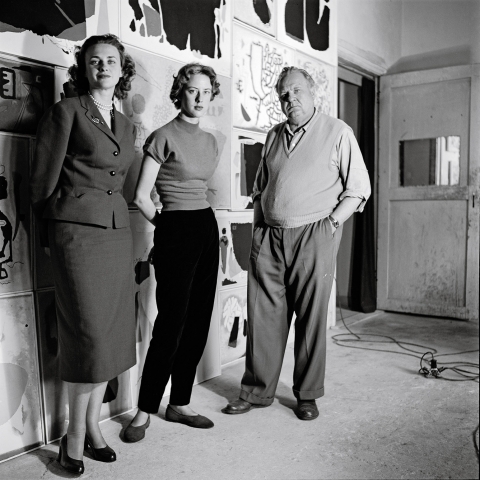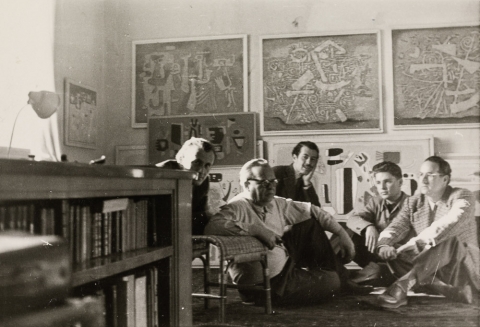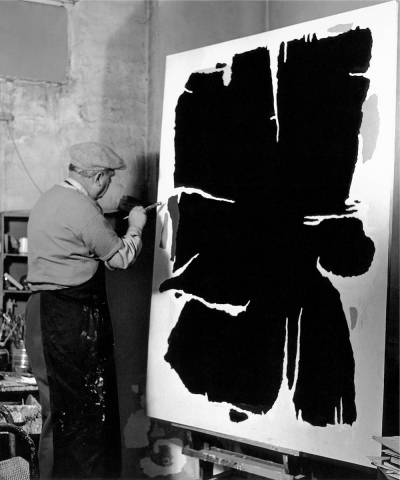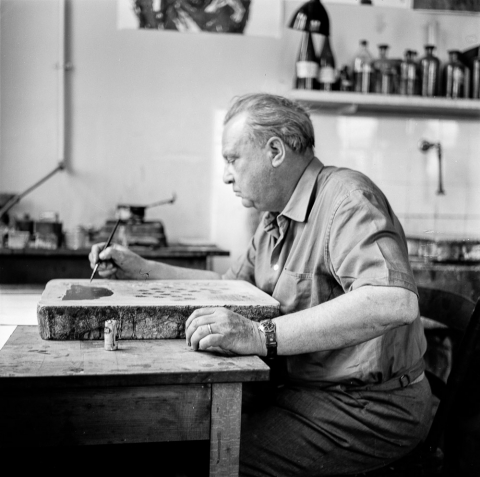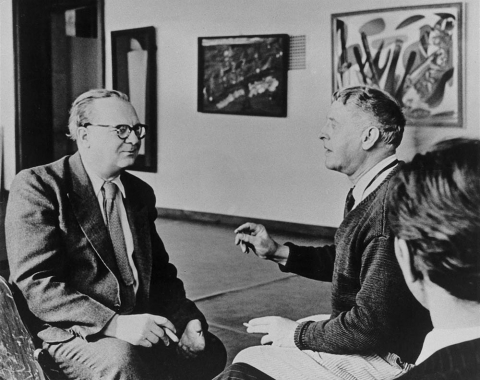The last five years of Willi Baumeister's life were more artistically productive than any of his previous work periods, even though he was extremely busy as both a teacher at the academy and representative of the modern period in numerous exhibitions as well as an uncompromising champion of contemporary art in public discourse.
His participation in an art congress in the Spanish Santillana del Mar in fall 1950 was the pinnacle of his involvement with prehistoric art and his research during the Wuppertal years from 1938 to 1945. Baumeister held a lecture on painting techniques and conservation issues of the stone-age Bison pictures in the Altamira cave. On the return trip he visited the house of Cézanne. In 1953 Baumeister saw a large Picasso exhibition in Milan, which disappointed him somewhat because he found these late works weaker.
A great deal of exciting developments can be found in the fruitful production of his late work, including the "Safer" sand pictures and "Metamorphoses", the "Aru", "Montaru" and "Monturi" series, and the "Han-i" paintings. He was still intensely involved with different printing techniques such as silkscreen printing and lithography as well as with stage designs. With a number of exhibition posters, book covers, and smaller printed materials he produced commercial deaigns again, too, although far fewer than in the 1920s.
Death in the Studio
On August 31, 1955 Willi Baumeister died while at work on a small painting. His death came unexpectedly - he was found sitting at the easel. His ashes were interred in the presence of many friends and colleagues in Stuttgart's Pragfriedhof..
Only later would it become clear what an unexpected loss the art world had suffered and what legacy he had left to posterity.
Exhibitions and Honors
In 1950 the first exhibition of the group ZEN 49 took place, which Baumeister, Fritz Winter, and others had founded a year earlier. At the First Biennale of the Museo de Arte Moderna in São Paulo, Baumeister received the first prize.
But the highlight of these years was a solo exhibition at the New York Hacker Gallery in April 1952 - his first exhibition in the USA. In 1954, on the occasion of Baumeister's 65th birthday, the Württembergischer Kunstverein organized a comprehensive retrospective with about 150 works.
In February 1955 Willi Baumeister was awarded the Gustav Klimt Honor by the Vienna Secession.
Champion of the Modern
In summer 1950 the first so-called Darmstadt Dialogue took place. Baumeister participated in a discussion titled "The Idea of Man in Our Times", along with well-known art historians such as Gustav Friedrich Hartlaub, Hans Hildebrandt, and Hans Sedlmayr, psychoanalyst Alexander Mitscherlich, and philosopher Theodor Adorno.
The Dialogue ended in a quarrel as Sedlmayr and Baumeister's positions clashed fiercely with one another. Sedlmayr had already taken a clear position against abstract art in his 1948 book "Verlust der Mitte" (Art in Crisis: The Lost Center), while Baumeister and others defended it.
He was similarly uncompromising in fall 1954 when he withdrew in protest from the Deutscher Künstlerbund ( Association of German Artist), after belonging to its executive board since its new founding in 1950. Baumeister found that in an interview on non-representational painting, Karl Hofer (1878-1955) had expressed a disparaging view. This was preceded by a polemic public debate over non-.representational art between Hofer and art critic (and Baumeister biographer) Will Grohmann, a vehement advocate and promoter of abstract art.
Theater
Since the end of the war, Baumeister was also very much occupied with the production of stage designs and costumes. Among these Egon Vietta's play "Die Drei Masken" (The Three Masks) in Wuppertal 1952 and theater performance of Max Komerell's "Kasperle-Spiele für grosse Leute" (Punch and Judy Shows for Grown-Ups) in Darmstadt 1953 were especially great successes. Sometimes the stage designs were reviewed more positively than the plays themselves, as Baumeister once noted in his diary.

